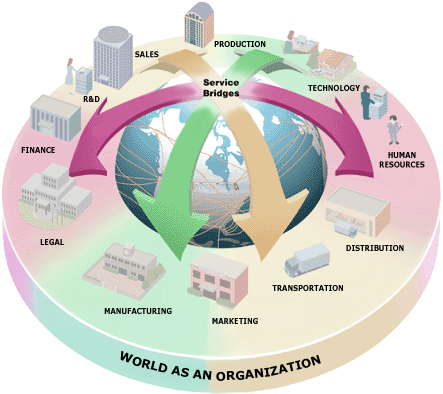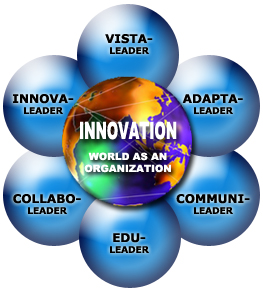 | ||

|
IN THIS ISSUE:
Conference Proceedings
Special Edition Home
.......................
SPECIAL POINTS OF INTEREST:
Newsflash:
We're excited about presenting this new thought leadership around the future role of the OD consultant. When you finish reading this special edition, should you have feedback, ideas, believe information is missing or needs to be elaborated, etc., we'd like to hear from you. Please contact us with your thoughts and suggestions.

WHAT’S NEXT? TRANSFORMATION,
INNOVATION AND NEXT GENERATION OD:
FROM AGENT OF CHANGE TO AGENT OF CONNECTION
Yael S. Zofi, President and CEO, and Keren R. Hillman, Consultant
AIM Strategies®, Applied Innovative Management®
Session Overview: The session draws on the experience of AIM Strategies®, in their quest to define the future role of the OD Consultant. It will address the changing nature of our field, as participants review the OD Generations Chart (Past and Present Theories, Practices and Applications), engage in an experiential exercise to delve into forecasting, “What’s Next”, and, finally, consider OD from the perspective of 2024. Session format will include an interactive dialogue and group discussion to explore how we facilitate innovation and connection in the rapid world of tomorrow. After looking into research around the changing nature of the global business environment, organizational leaders and the role of OD, participants will explore the transformation of the OD consultant – from Agent of Change to Agent of Innovation and Connection!
Introduction: Recent world events have underscored the importance of adaptability. The OD discipline is uniquely equipped to deal with the challenge of helping organizations function in an environment characterized by constant transformation. While access to and transfer of knowledge is instantaneous, it is the OD professional who enables the social life of this knowledge.
What? - The Challenge
The world is increasingly
complex and uncertain, as ‘more, better, faster’ has
become a common refrain. The future is arriving
more quickly than anyone would have predicted,
sending tremors throughout organizational life. Here
are some selected trends that are changing
the world, as we know it.
Globalization – an unstoppable force
- Globalization in this Information Age is seen as the most progressive global movement since the Industrial Revolution. The Internet has enabled this "Global Village" to be truly "connected" 24/7, with technology and ideas spreading at an unprecedented pace.
- The political reality of the global market is the explosion of capitalism and a free market economy. In the last 10 years the growth of capitalism has created three billion new capitalists due to changes in the Russian Republics, China, India and large parts of Africa.
- In the post 9/11 world people are looking to their government and employers to provide a safer work environment.
- Global environmental concerns range from local pollution to global warming.
- The shortage of water is probably going to be the most serious resource problem that the world will face in twenty years. Today, over 80 countries experience water shortages of some type. Will we see wars over water instead of wars over oil?
- Biogenetics cannot be ignored - it threatens to forever genetically alter the human species and expand our life expectancies. Such technologies as Traneugenics, using animals for human organ banks and genetic screening that identifies potential predisposition to certain illnesses, will create longer life expectancies. World demographics show dramatic shifts.
- The world population is changing. In the 1950’s a third of humankind lived in the developed world. Now less than 25% do. By 2024 less then one fifth will.
- The developed world is growing older, with a slowing population growth. Throughout the developed world, the number of people over 65 will rise 60% by the year 2025.
- By 2050, the white population of the US may not be a majority. Hispanics are expected to make up 25% of the population, Asians 10% and African-Americans 16%.
- A new generation of airplanes are projected to reduce flying times by at least 25%.
- With computers that recognize human speech and software programs that convert text from one language to another, we are not far from simultaneous audible language translation.
- Information technology will create “Pervasive Knowledge Network”: anytime anyplace access to voice or video communication, Internet or network computer access and entertainment. By the year 2015, 50% of employees will perform their jobs at least partially from remote locations by telecommuting.
- As virtual reality (VR) techniques improve, ultimately the individual will the physical presence of others if the simulation experience is real enough. Less and less dependence on physical needs comes with increasing technology.
- By the year 2050, sophisticated robots that have
sensory input will make decisions, have the
ability to learn and be mobile, will become
commercially available.
Current State: Developed and Developing World
Developed World – nations that have achieved a higher degree of industrialization and tend to enjoy the higher standard of living, which wealth and technology make possible.
|
Developing World - nations have not achieved a significant degree of industrialization relative to their populations and tend to have a lower standard of living.
|
|
So What? - The Impact:
The world continues
to evolve into a free market environment, eventually
resulting in one big market, with all of us
acting as players in that market. As these
dramatic shifts occur in the global landscape,
organizations will find themselves functioning
in one interlocking system, sharing resources,
labor markets and consumers. In addition,
ongoing improvements in technology will further
decrease boundaries. Already, one can sit anywhere
and communicate instantly anytime and anyplace
in the world. Imagine having a plasma screen
(connected to the phone or computer) facilitating
virtual meetings with global colleagues.
Think of our world as a system comprised of inputs and outputs across boundaries, constantly interacting with each other in a dynamic process that stimulates (or yields) value. With this perspective, thinking locally is no longer an option. One can also think of an organization as a system comprised of interacting elements (people, business functions, etc.) that acquires inputs (raw materials, knowledge) from its environment and transforms them into marketable outputs (products / services), which are discharged into the external environment. Therefore, the world can be depicted as an organization. The following visual illustrates this concept: 
Globalization has impacted
our current business environment and will
continue to do so. With outsourcing and
offshoring, many manufacturers have migrated
production to facilities in the developing
world, just as service providers have done
likewise with their customer support function. These
developments have brought new job opportunities
to the developing world, where labor cost
is low, and at the same time will lead to
redeployment of labor and reduced costs in
the developed world – benefiting both parties. Increasingly,
Americans (and their counterparts in other
developed nations) are afraid, as they perceive
their own job functions becoming marginalized. However,
some argue that these trends will not mean
fewer jobs in the developed world, but rather
that many jobs will be created that involve
innovation and strategic management where
the knowledge is centered.
Welcome to The 21st Century (21C)
A typical 21C organization will be boundaryless,
its reach extending into different countries
and cultures, all connected through a complex
web of technology. A typical 21C employee
will be nimble, able to function in non-linear
ways as noted below:
Now What? – The Result … Innovation
1. Characteristics of the NEW 21C Leader:
Leadership propels organizations
along these roads of hairpin turns and blind
curves that extend further and further out
from core business. Being a global leader
is no longer an option – it’s a requirement
for maintaining a strong and secure place in
the market. The role of the 21C leader will
be to encourage – and practice - innovation
as a lynchpin of competitive advantage.
Guiding organizations to
achieve effectiveness will require leaders
with new characteristics. Those who are going
to be the innovators are going to be the leaders.
This may be a paradigm shift and requires new
leadership roles.
We believe that successful 21C leaders will exhibit a combination of these
six leadership roles - Vista-Leader, Innova-Leader,
Adapta-Leader, Collabo-Leader, Communi-Leader
and Edu-Leader – as described on the following
page:
NEW 21C Leader:
|
